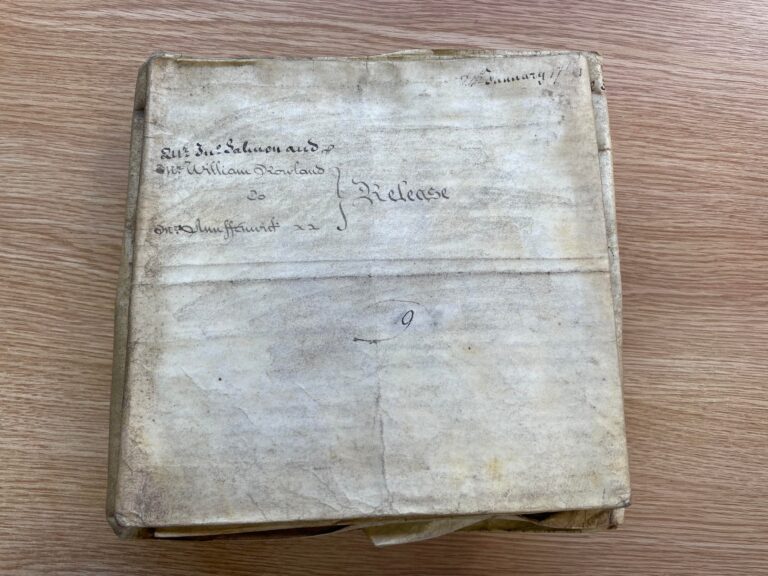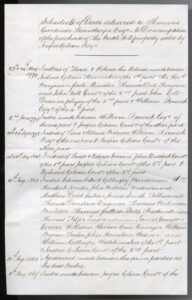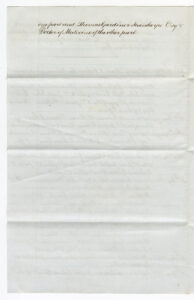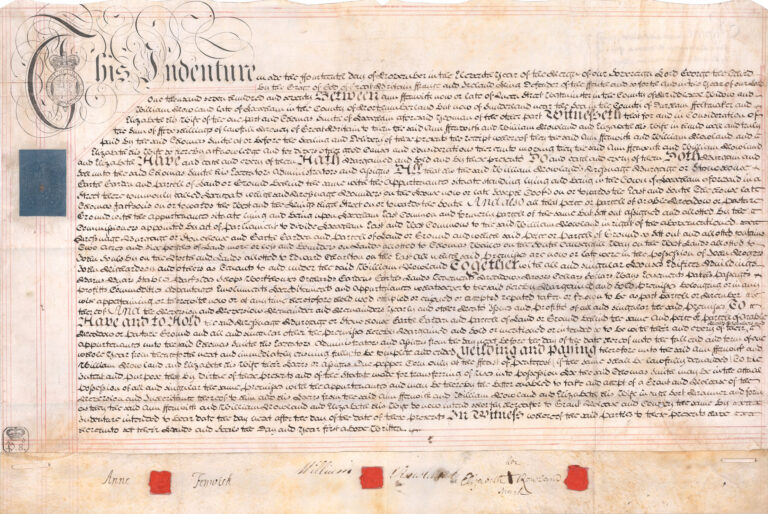DEEDS
Before starting your research you should try and locate the deeds to the property. If you own the property the deeds may be in your care or with your mortgage provider or solicitor. In recent years, title to property has been recorded electronically. This meant that some deeds in the hands of mortgage providers were disposed of. Generally, Archive Services do not collect deeds as a matter of course. Some deeds have come into the care of Northumberland Archives from families and solicitors. There is only a slim chance that deeds to of the property that you are researching will be held by Northumberland Archives. Try searching our online catalogue for reference to any deeds. Not all collections are listed in our catalogue. If you cannot find any reference in the catalogue staff will be pleased to advise you further.
What Are Deeds?
Deeds are a legal record of transactions on a property. It may be possible to trace the full history of ownership of a property if a complete series of deeds survives for the property. They also provide useful clues to other sources to check.
Forms of Tenure
Before looking at deeds it is important to understand the various forms of tenure that existed. These are summarised below:
As the name suggests the original freehold ‘tenants’ were free i.e. they were not subject to the same manorial customs as copyhold tenants. Generally, freehold property was the most substantial property on a manor or estate and occupied by more wealthy persons. Until the 1832 Reform Act only males aged between 21 or over who owned a freehold property were eligible to vote in Parliamentary elections. Freeholders were also liable for jury service – if the property you are researching was freehold you may find reference to the freeholder in a jury list – see more information in the Residents section. The term freehold is often used today to refer to properties where both the building and the land upon which it stands is owned by the same person.
The term copyhold indicates that a property formed part of a manor. Copyhold tenants were ‘unfree’ tenants who were expected to provide services to the Lord of the Manor. Copyhold tenants held their property for life (unless they chose to dispose of it) and could pass it on to the next of kin as set down in the ‘rules’ of the manor. The term copyhold arises because details of any property transaction were ‘copied‘ into the manor court roll. Copyhold tenure continued until the 1920’s when copyhold rights were extinguished. See section on manorial records for more information.
From the 16th century copyhold tenure was gradually converted to leasehold. Leasehold property was held for a limited period of time. There were various formats that leasehold might take. The most popular ones were:
- Lease for (generally three) lives – the lease expired when the last named person on the lease died. It was possible to add subsequent names for a fee.
- Fixed leases – set for a stipulated period of time with a fixed sum of money paid at the time the lease was entered into.
- Periodic leases – also for fixed stipulated periods of time but these could be automatically renewed. Rent was usually paid weekly, monthly or half yearly.
The term leasehold is often used today to refer to properties where the building is owned by the occupier but the land by another. The owner then pays a ground rent to the landowner.
Abstracts of Title
If you are able to locate any relevant deeds you will generally be presented with a bundle of parchment or paper documents. The best strategy is to look for the abstract of title – a document summarising the contents of the bundle. This should be your starting point. Where an abstract of title survives, it may not be necessary to look at individual deeds in detail to extract information.
Northumberland Archives holds two bundles of deeds relating to a property in Battle Hill, Hexham (ref: NRO 467/2). The bundles form part of the records of E.W.S, Portnell, solicitors of Hexham. Within one of the bundles there is a schedule of deeds or abstract of title relating to the property.
Give it a go
Reading the document, we learn that the abstract was drawn up when Dr. Thomas Gardiner Stainthorpe purchased the property from Jasper Gibson in 1867. The document records all of the transactions on the property dating back to 1774. It is important to note all of the parties to the transactions – their names and occupations. Details of occupations can lead to other records. See section on residents.
NRO 467/2/1 Schedule of Deeds relating to property in Battle Hill, Hexham, Northumberland, nd. [c.1867]
An Abstract of Title or Schedule of Deeds provide an easily accessible summary of the transactions on a property over a number of years. We learn from the text at the head of this document that it is a Schedule of Deeds drawn up to list the deeds that were presented to Dr. Thomas Gardiner Stainthorpe ‘… on completion of the purchase of The Battle Hill property sold by Jasper Gibson Esq.’. The date of the purchase is noted at the end of the schedule and is recorded in this table. We learn that the purchase took place on 18 May 1867. This simple document sets out the ownership of the property over almost 90 years.
It is important to look at this document in conjunction with the actual deeds which will provide additional information, for example, the deeds should record the place of residence of the parties, will provide a description of the property being transacted and the terms of the transaction.
Date | Transaction |
23-24 May 1774 | Property passes to William Fenwick, Esquire. Other parties are: 1. Joshua Gibson, shoemaker. 2. Rev. Benjamin Peele, Minster; Thomas Ord, surgeon and John Bell, gentleman. 3. Dr. John Gill. 4. William Fenwick, Esquire. |
2 June 1774 | Transaction on property between William Fenwick Esquire and Jasper Gibson, gentleman. |
28-29 September 1778 | Lease and release (conveyance) of property from William Fenwick Esquire and Jasper Gibson, gentleman. |
14-15 May 1840 | Lease and release (conveyance) of property between John Ruddock, gentleman, Jasper Gibson, gentleman and Richard Gibson, gentleman. |
10 August 1863 | Transaction on property between: 1. Edward Gilhespy, pointsman; Willliam Havelock, forester; John Balden, understeward; Matthew Dodd, builder; James Smith, tobacconist; Thomas Davidson, engineer; Thomas Bulman, builder; Thomas Palliser Dods, husbandman; Thomas Telfer, husbandman; James Jameson, grocer; William Watson, gas manager; William Byron, tailor; John Hamilton, weaver and William Gilhepsy, watchmaker. 2. Jasper Gibson, gentleman. |
10 August 1863 | Second transaction between: 1. Edward Gilhespy, pointsman; Willliam Havelock, forester; John Balden, understeward; Matthew Dodd, builder; James Smith, tobacconist; Thomas Davidson, engineer; Thomas Bulman, builder; Thomas Palliser Dods, husbandman; Thomas Telfer, husbandman; James Jameson, grocer; William Watson, gas manager; William Byron, tailor; John Hamilton, weaver and William Gilhepsy, watchmaker. 2. Jasper Gibson, gentleman. |
18 May 1867 | Property sold by Jasper Gibson, gentleman, to Dr. Thomas Gardiner Stainthorpe. |
Reading Deeds
Reading deeds can be challenging. The handwriting may be difficult. The documents do not have punctuation and it is easy to lose your place in the document and the sense of what is being described. The skill is to identify the relevant section of the document and extracting the relevant data from this therefore avoiding reading the whole document. You therefore need to become familiar with the various clauses within the document. These are:
begins with THIS INDENTURE – usually includes the date. The date may be written as a regnal year – the year the monarch acceded to the throne. This website converts regnal years to calendar years – https://www.bosburyhistoryresource.org.uk/DD/regnal-year-converter.html
begins with BETWEEN. There can be any number of parties to a deed and a party can consist of several persons. Occupations and places of residence are usually given. Where there are only two parties and the deeds refers to the sale of a property, the first is usually the vendor or and the second the purchaser.
this section refers to previous transactions on the property. Begins with WHEREAS. This section can often contain the most useful genealogical information about the parties.
- TESTATUM – the actual terms of the contract. Begins with NOW THIS
INDENTURE WITNESSETH.
2. HABENDUM – details length of contract with any additional conditions.
Begins with TO HAVE AND TO HOLD.
begins with IN WITNESS THEREOF. Details witnesses & usually includes signatures of parties.
Give it a go
Have a go at trying to read the example deed. What can you learn from it?
For more information on how to read handwritten documents see our Decoding Manuscripts module.
This deed (NRO 467/1) relates to a property in Hexham.
Date: 11 November 1770
Parties:
- Ann Fenwick, widow, now or late of Queen Street, Westminster, Middlesex; William Rowland, feltmaker, late of Hexham in the county of Northumberland, now of Sunderland by the Sea, in the County of Durham & Elizabeth, his wife.
- Thomas Smith, yeoman, of Hexham, Northumberland.
Transaction: Bargain and Sale.
Property: Messuage Burgage or Stonehouse Garth Garden and Parcell of Land or Ground behind the same with the Appurtenances situate standing lying in the Town of Hexham aforesaid in a Street there commonly called Hencoats …. .
Street Names
Something to be aware of is that street names did not always exist – in small settlements it wasn’t necessary to identify a property by address. Also that street names and even house numbers changed over time.
Currency
Deeds provide details of the monetary transaction that took place. These currency convertors help understand the value of money in past centuries:
Bank of England Inflation Calculator
https://www.bankofengland.co.uk/monetary-policy/inflation/inflation-calculator
National Archives Currency Convertor https://www.nationalarchives.gov.uk/currency-converter/
The Land Registry
The Land Registry was established in 1862 to record land transfers in England and Wales. However, compulsory recording of information did not come into being until 1990 although in reality this has probably been the case since the 1970’s. Principally local Land Registries keep records of current ownership of land and can provide (for a fee) copies of any maps and plans that they may hold as well as information about the most recent sale of the property. In some instances, they do hold historic information re. the property but this is likely to relate only to recent transactions.
The Land Registry website can be found here – https://www.gov.uk/government/organisations/land-registry
Terminology
The following terms are commonly used to describe property within deeds:
Burgage – a small area of land possibly a field.
Curtilage – yard and outbuildings of a house.
Garth – yard or enclosure.
Messuage – a house, outbuildings & possibly a garden.
Capital Messuage – large house.
Tenement – a formal description of any type of property but particularly property including a building.
Reading List
N.W. Alcock Old Title Deeds; A Guide For Local & Family Historians (Phillimore 1986)
A.A. Dibben Title Deeds (Historical Association 1971)
Websites
Nottingham University website provides useful information about using deeds in research including guidance on how to identify particular types of documents.





